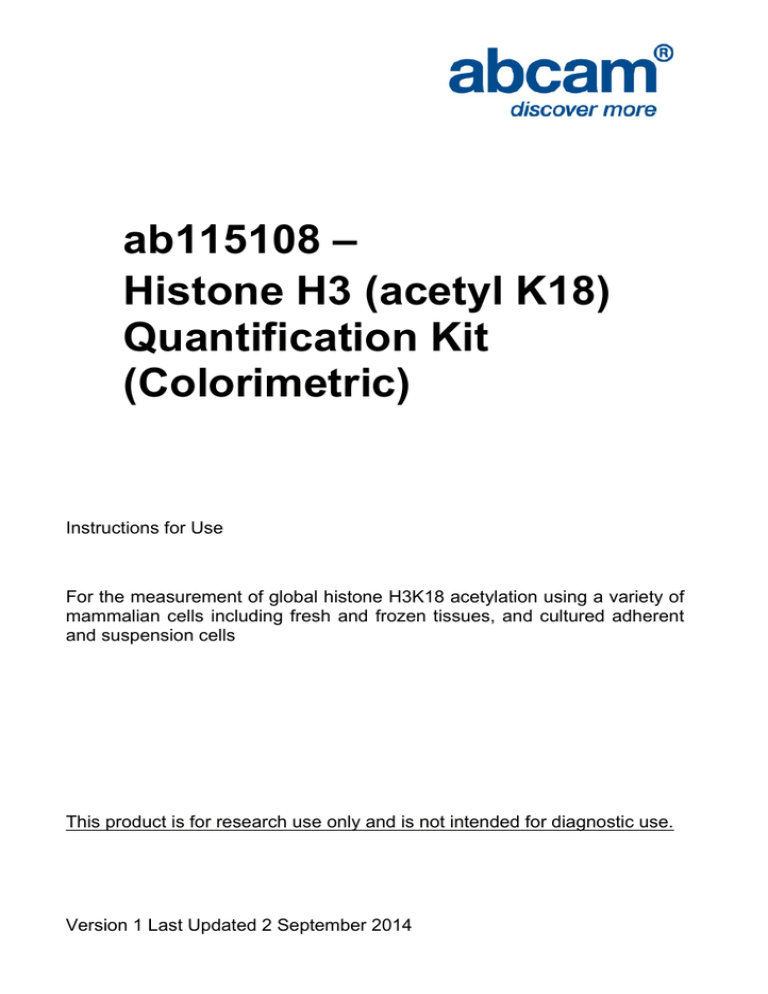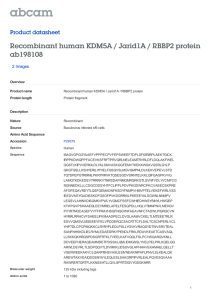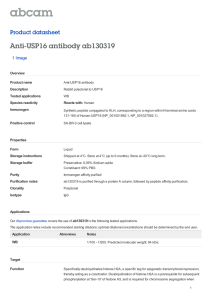ab115108 – Histone H3 (acetyl K18) Quantification Kit (Colorimetric)
advertisement

ab115108 – Histone H3 (acetyl K18) Quantification Kit (Colorimetric) Instructions for Use For the measurement of global histone H3K18 acetylation using a variety of mammalian cells including fresh and frozen tissues, and cultured adherent and suspension cells This product is for research use only and is not intended for diagnostic use. Version 1 Last Updated 2 September 2014 Table of Contents INTRODUCTION 1. BACKGROUND 2 2. ASSAY SUMMARY 3 GENERAL INFORMATION 3. PRECAUTIONS 4 4. STORAGE AND STABILITY 4 5. MATERIALS SUPPLIED 5 6. MATERIALS REQUIRED, NOT SUPPLIED 5 7. LIMITATIONS 6 8. TECHNICAL HINTS 6 ASSAY PREPARATION 9. REAGENT PREPARATION 7 10. SAMPLE PREPARATION 7 11. PLATE PREPARATION 8 ASSAY PROCEDURE 12. ASSAY PROCEDURE 9 DATA ANALYSIS 13. ANALYSIS 10 RESOURCES 14. TROUBLESHOOTING 11 15. NOTES 12 Discover more at www.abcam.com 1 INTRODUCTION 1. BACKGROUND Acetylation of histones, including histone H3, has been involved in the regulation of chromatin structure and recruitment of transcription factors to the gene promoters. Histone acetyltransferases (HATs) and histone deacetylases (HDACs) play a critical role in control of histone H3 acetylation at multiple sites. Histone H3 at lysine 18 (H3K18), along with K9 and K14, are primary acetylated sites of histone H3. Acetylation of histone H3K18 is tightly involved in the cell cycle regulation, cell proliferation and apoptosis. Acetylation of histone H3K18 is also correlated with transcription activation. An imbalance in the equilibrium of histone H3 acetylation, including K18 acetylation, has been associated with tumorigenesis and cancer progression. Histone H3K18 acetylation may be increased by inhibition of HDACs and decreased by HAT inhibition. Thus, quantitative detection of global acetyl histone H3K18 would provide useful information for better understanding epigenetic regulation of gene activation, and for developing HAT or HDAC-targeted drugs. ab115108 provides a tool for measuring global acetylation of histone H3K18. This kit has the following features: Quick and efficient procedure, which can be finished within 2.5 hours Innovative colorimetric assay without the need for radioactivity, electrophoresis, or chromatography Specifically captures H3K18ac with the detection limit as low as 2 ng/well and detection range from 20 ng-5 μg/well of histone extracts The control is conveniently included for the quantification of the amount of H3K18ac Strip microplate format makes the assay flexible: manual or high throughput Simple, reliable, and consistent assay conditions Discover more at www.abcam.com 2 INTRODUCTION Abcam’s Histone H3 (acetyl K18) Quantification Kit (Colorimetric) is designed for measuring global histone H3K18 acetylation. In an assay with this kit, the acetyl histone H3 at lysine 18 is captured to the strip wells coated with an anti-H3K18ac antibody. The captured acetyl histone H3K18 can then be detected with a labeled detection antibody followed by a color development reagent. The ratio of H3K18ac is proportional to the intensity of absorbance. The absolute amount of H3K18ac can be quantified by comparing to the standard control. 2. ASSAY SUMMARY Tissue disaggreagation or cell lysis Histone extracts H3K18ac bound to assay wells Add detection antibody after wash Add color developing solution for color development and measure absorbance Discover more at www.abcam.com 3 GENERAL INFORMATION 3. PRECAUTIONS Please read these instructions carefully prior to beginning the assay. All kit components have been formulated and quality control tested to function successfully as a kit. Modifications to the kit components or procedures may result in loss of performance. 4. STORAGE AND STABILITY Store kit as given in the table and away from light upon receipt. Observe the storage conditions for individual prepared components in sections 9 & 10. For maximum recovery of the products, centrifuge the original vial prior to opening the cap. Check if the 10X Wash Buffer and Antibody Buffer contain salt precipitates before use. If so, warm at room temperature or 37°C and shake the buffer until the salts are re-dissolved. Discover more at www.abcam.com 4 GENERAL INFORMATION 5. MATERIALS SUPPLIED Item Storage Condition (Before Preparation) 4°C 48 Tests 96 Tests 10X Wash Buffer 10 mL 20 mL Antibody Buffer 6 mL 12 mL 4°C Detection Antibody, 1 mg/mL 5 µL 10 µL -20°C Color Developer 5 mL 10 mL 4°C Stop Solution 3 mL 6 mL 4°C Standard Control, 100 µg/mL 10 µL 20 µL -20°C 8-Well Sample Strips (with Frame) 4 9 4°C 8-Well Standard Control Strips* 2 3 4°C *These wells are identified by a green ring around the top. 6. MATERIALS REQUIRED, NOT SUPPLIED These materials are not included in the kit, but will be required to successfully utilize this assay: Pipettes and pipette tips Reagent reservoirs Orbital shaker Microplate reader Discover more at www.abcam.com 5 GENERAL INFORMATION 7. LIMITATIONS Assay kit intended for research use only. Not for use in diagnostic procedures Do not use kit or components if it has exceeded the expiration date on the kit labels Do not mix or substitute reagents or materials from other kit lots or vendors. Kits are QC tested as a set of components and performance cannot be guaranteed if utilized separately or substituted Any variation in operator, pipetting technique, washing technique, incubation time or temperature, and kit age can cause variation in binding 8. TECHNICAL HINTS Avoid foaming or bubbles when mixing or reconstituting components Avoid cross contamination of samples or reagents by changing tips between sample, standard and reagent additions Ensure plates are properly sealed or covered during incubation steps Complete removal of all solutions and buffers during wash steps This kit is sold based on number of tests. A ‘test’ simply refers to a single assay well. The number of wells that contain sample, control or standard will vary by product. Review the protocol completely to confirm this kit meets your requirements. Please contact our Technical Support staff with any questions Discover more at www.abcam.com 6 ASSAY PREPARATION 9. REAGENT PREPARATION 9.1 9.2 1X Wash Buffer Dilute 10X Wash Buffer with distilled water (pH 7.2-7.5) at a 1:10 ratio (1 mL of 10X Wash Buffer + 9 mL of water).This diluted 1X Wash Buffer can now be stored at 4°C for up to six months. Detection Antibody Dilute Detection Antibody (at a 1:1000 ratio) to 1 μg/mL with Antibody Buffer. 10. SAMPLE PREPARATION Prepare histone extracts from cells/tissues treated or untreated by using your own successful method (acid extraction or high salt extraction). For your convenience and the best results, Abcam offers the Histone Extraction Kit (ab113476) optimized for use in Abcam’s modified histone quantification series. Alternatively, preparation of histone extracts can also be performed using the procedure below: 10.1 For tissues (treated and untreated), weigh the sample and cut the sample into small pieces (1-2 mm3) with a scalpel or scissors. Transfer tissue pieces to a Dounce homogenizer. Add TEB buffer (PBS containing 0.5% Triton X 100, 2 mM PMSF and 0.02% NaN3) at 200 mg/mL, and disaggregate tissue pieces by 50-60 strokes. Transfer homogenized mixture to a 15 mL conical tube and centrifuge at 3000 rpm for 5 minutes at 4°C. If total mixture volume is less than 2 mL, transfer mixture to a 2 mL vial and centrifuge at 10,000 rpm for 1 minute at 4°C. Remove supernatant. For cells (treated and untreated), harvest cells and pellet the cells by centrifugation at 1000 rpm for 5 minutes at 4°C. Resuspend cells in TEB buffer at 107 cells/mL and lyse cells on ice for 10 minutes with gentle stirring. Centrifuge at 3000 rpm for 5 minutes at 4°C. If total volume is less than 2 mL, transfer cell lysates to a 2 mL vial and centrifuge at 10,000 rpm for 1 minute at 4°C. Remove supernatant. Discover more at www.abcam.com 7 ASSAY PREPARATION 10.2 Resuspend cell/tissue pellet in 3 volumes (approx. 200 μL/107 cells or 200 mg tissues) of extraction buffer (0.5N HCl + 10% glycerol) and incubate on ice for 30 minutes. 10.3 Centrifuge at 12,000 rpm for 5 minutes at 4°C and remove the supernatant fraction to a new vial. 10.4 Add 8 volumes (approx. 0.6 mL/107 cells or 200 mg tissues) of acetone and leave at -20°C overnight. 10.5 Centrifuge at 12,000 rpm for 5 minutes and air-dry the pellet. Dissolve the pellet in distilled water (30-50 μL/107 cells or 200 mg tissues). 10.6 Quantify the protein concentration. Aliquot the extract and store the extract at -20°C or -80°C. Histone extracts can be used immediately or stored at -80°C for future use. 11. PLATE PREPARATION Strip 1-3 (for 96 assays) or strip 1-2 (for 48 assays) – standard wells (green trimmed); the standard curve can be generated with 5-8 concentration points (includes blank). Example amount of standard control/well - A1: 100 ng; B1: 50 ng; C1: 25 ng; D1: 12 ng; E1: 6 ng; F1: 3 ng; G1: 1.5 ng; H1: 0 ng. Strip 4-12 (for 96 assays) or strip 3-6 (for 48 assays) – sample wells (No label). Each sample or standard point can be assayed in duplicates or triplicates. Discover more at www.abcam.com 8 ASSAY PROCEDURE 12. ASSAY PROCEDURE 12.1 Predetermine the number of strip wells required. Remove un-needed strip wells from the plate frame and place them back in the bag (seal the bag tightly and store at 4°C). 12.2 Add 50 μL of Antibody Buffer into each well. For the sample, add 12 μg of the histone extract into the sample wells. For the standard curve, dilute the Standard Control with Antibody Buffer to 1-100 ng/μL at 5-7 points (e.g., 1.5, 3, 6, 12, 25, 50, and 100 ng/μL). Add 1 μL of the Standard Control at the different concentrations into the standard wells (ringed in green). For the blank, do not add any nuclear extracts or standard control protein. Mix and cover the strip wells with Parafilm M and incubate at room temperature for 1-2 hours. 12.3 Aspirate and wash the wells with 150 μL of 1X Wash Buffer three times. 12.4 Add 50 μL of Diluted Detection Antibody to each well and incubate at room temperature for 60 minutes on an orbital shaker (100 rpm). 12.5 Aspirate and wash the wells with 150 μL of 1X Wash Buffer six times 12.6 Add 100 μL of the Color Developer into the wells and incubate at room temperature for 2-10 minutes away from light. Monitor the color development in the sample and standard wells (blue). 12.7 Add 50 μL of Stop Solution to each well to stop enzyme reaction when the color in the standard wells containing the higher concentrations of standard control turns medium blue. The color should change to yellow and absorbance can be read on a microplate reader at 450 nm within 2-15 minutes. 12.8 Calculate % histone H3K18 acetylation using the formulae provided in Section 13 – Data Analysis. Discover more at www.abcam.com 9 DATA ANALYSIS 13. ANALYSIS Calculate the % Histone H3K18 acetylation using the following formula: Acetylation % = Treated (Tested) Sample OD – Blank OD x 100% Untreated (Control) Sample OD – Blank OD For the amount quantification, plot OD versus amount of Standard Control and determine the slope as delta OD/ng. Calculate the amount of H3K18ac using the following formula: Amount (ng/mg protein) = Sample OD – Blank OD x 1000 Protein (µg)* x Slope *Histone extract amount added into the sample well at step 12.2. Discover more at www.abcam.com 10 RESOURCES 14. TROUBLESHOOTING Problem No Signal for Both the Standard Control and the Samples Cause Reagents are added incorrectly Incubation time and temperature is incorrect No Signal or Very Weak Signal for Only the Standard Control No Signal for only the Sample The amount of standard control is not added into “standard control wells” or is added insufficiently The protein sample is not properly extracted The protein amount is added into well insufficiently Protein extracts are incorrectly stored High Background Present for the Blank The well is not washed enough Contaminated by the standard control Overdevelopment Discover more at www.abcam.com Solution Check if reagents are added in order and if some steps of the procedure are omitted by mistake Ensure the incubation time and temperature described in the protocol are correctly followed Ensure sufficient amount of control is properly added to the standard control well Ensure the procedure and reagents are correct for the nuclear protein extraction Ensure extract contains sufficient amount of proteins Ensure the nuclear extracts are stored at -20°C or -80°C Check if wash at each step is performed according to the protocol Ensure the well is not contaminated by adding the control protein or by using control protein contaminated tips Decrease development time at step 12.6 11 RESOURCES 15. NOTES Discover more at www.abcam.com 12 RESOURCES Discover more at www.abcam.com 13 RESOURCES Discover more at www.abcam.com 14 UK, EU and ROW Email: technical@abcam.com | Tel: +44-(0)1223-696000 Austria Email: wissenschaftlicherdienst@abcam.com | Tel: 019-288-259 France Email: supportscientifique@abcam.com | Tel: 01-46-94-62-96 Germany Email: wissenschaftlicherdienst@abcam.com | Tel: 030-896-779-154 Spain Email: soportecientifico@abcam.com | Tel: 911-146-554 Switzerland Email: technical@abcam.com Tel (Deutsch): 0435-016-424 | Tel (Français): 0615-000-530 US and Latin America Email: us.technical@abcam.com | Tel: 888-77-ABCAM (22226) Canada Email: ca.technical@abcam.com | Tel: 877-749-8807 China and Asia Pacific Email: hk.technical@abcam.com | Tel: 108008523689 (中國聯通) Japan Email: technical@abcam.co.jp | Tel: +81-(0)3-6231-0940 www.abcam.com | www.abcam.cn | www.abcam.co.jp Copyright © 2014 Abcam, All Rights Reserved. The Abcam logo is a registered trademark. All information / detail is correct at time of going to print. RESOURCES 15



